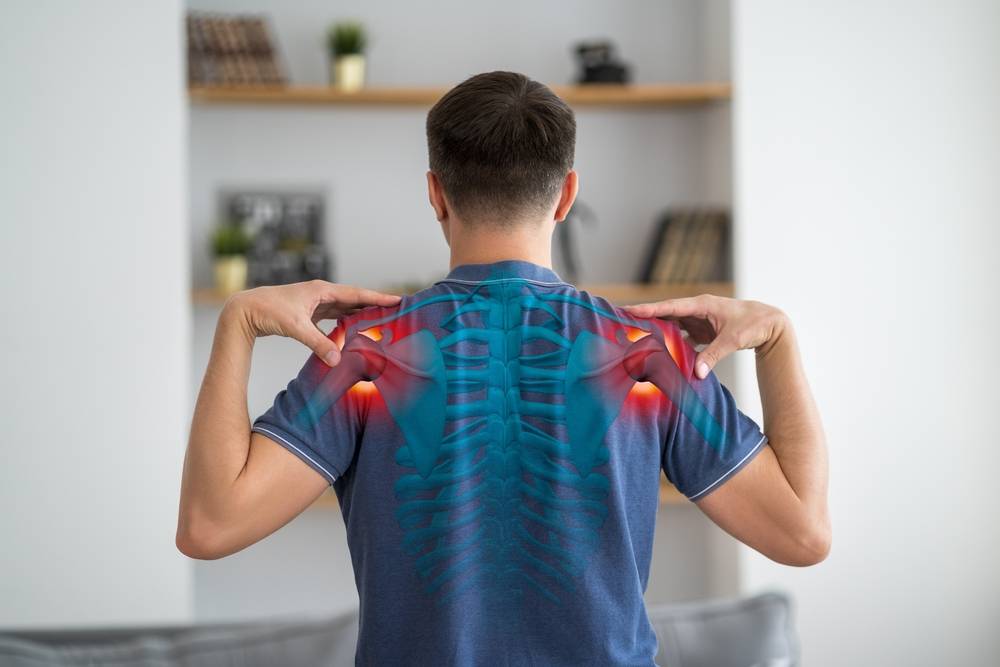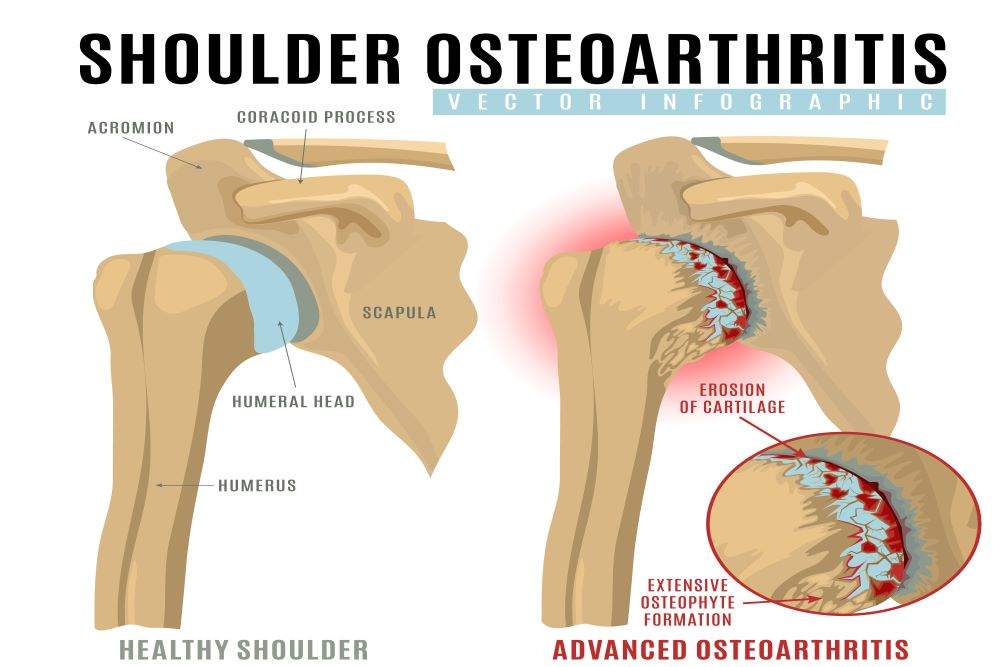 Millions of people are diagnosed with arthritis each year. While you might think of arthritis as commonly affecting hands and wrists, arthritis can occur in any joints in the body. The shoulder joints are another common place where arthritis can occur. You depend on the shoulder joints for a wide range of motion and going about everyday tasks. Shoulders experience a lot of wear and tear throughout a lifetime. Arthritis refers to inflammation in the joints, and many types of arthritis exist. Shoulder arthritis can cause pain and stiffness, making previously easy movements and activities uncomfortable. If you experience pain in one or both shoulders, talk to your doctor about your symptoms and learn more about how shoulder arthritis may affect you.
Millions of people are diagnosed with arthritis each year. While you might think of arthritis as commonly affecting hands and wrists, arthritis can occur in any joints in the body. The shoulder joints are another common place where arthritis can occur. You depend on the shoulder joints for a wide range of motion and going about everyday tasks. Shoulders experience a lot of wear and tear throughout a lifetime. Arthritis refers to inflammation in the joints, and many types of arthritis exist. Shoulder arthritis can cause pain and stiffness, making previously easy movements and activities uncomfortable. If you experience pain in one or both shoulders, talk to your doctor about your symptoms and learn more about how shoulder arthritis may affect you.
Shoulder Anatomy
Did you know that your shoulders have the most movement of all the joints in your body? In fact, each shoulder contains two joints that support your upper body movement. The shoulder is where the upper arm bone, shoulder blade, and collarbone come together. The head of the upper arm bone, or humerus, fits into a socket made by the shoulder blade or scapula. This joint is known as the glenohumeral joint. The collarbone, or clavicle, also meets at the tip of the shoulder blade, known as the acromioclavicular joint. The glenohumeral and acromioclavicular joints make up what most people refer to as the shoulder joint. Muscles and tendons surround the shoulder to help keep the bones in place. This thick band of connective tissue is known as the rotator cuff. To determine the type of shoulder arthritis you have and the treatment options available, your doctor will want to determine where arthritis occurs.
Common Causes of Shoulder Arthritis
The most common causes of shoulder arthritis include joint degeneration, a health condition, or a shoulder injury. General wear and tear on the shoulders over time can lead to shoulder arthritis in adults over age 50, commonly known as osteoarthritis. The body can also trigger an inflammatory response that affects the lining of the joints, known as rheumatoid arthritis. A health condition that affects the healthy blood supply to the bones in your shoulder can lead to avascular necrosis. A shoulder injury like a shoulder dislocation or rotator cuff tear can cause post-traumatic arthritis or rotator cuff tear arthropathy. Bone spurs can also develop, which are small bone protrusions that can make movements uncomfortable and allow for bone-on-bone contact.
Types of Shoulder Arthritis
Five types of arthritis can affect the shoulder.
Osteoarthritis
 Most people think of osteoarthritis when they hear the term ‘arthritis’. This type of osteoarthritis is also known as wear and tear arthritis and occurs as the cartilage in joints starts to wear away. Cartilage helps prevent bones from rubbing against one another in the joint. Osteoarthritis is common in aging adults due to general wear and tear on the body. Cartilage loss can lead to uncomfortable symptoms and restricted movement in the joint.
Most people think of osteoarthritis when they hear the term ‘arthritis’. This type of osteoarthritis is also known as wear and tear arthritis and occurs as the cartilage in joints starts to wear away. Cartilage helps prevent bones from rubbing against one another in the joint. Osteoarthritis is common in aging adults due to general wear and tear on the body. Cartilage loss can lead to uncomfortable symptoms and restricted movement in the joint.
Rheumatoid Arthritis
Another common type of arthritis is known as rheumatoid arthritis. This type of arthritis is an autoimmune disorder where the body’s immune system attacks its own healthy cells. If you have rheumatoid arthritis, you are more likely to experience arthritis in both shoulders. Rheumatoid arthritis causes the linings of your joints to swell due to the immune response. This inflammation and swelling can lead to joint pain, stiffness, and other uncomfortable symptoms.
Post-Traumatic Arthritis
A previous injury to the shoulder, like a dislocated shoulder, can cause you to develop post-traumatic arthritis. This type of arthritis is a form of osteoarthritis, though it can resolve with proper treatment. Post-traumatic arthritis can cause inflammation in the joint where you experienced an injury. Unlike typical osteoarthritis, post-traumatic arthritis typically develops quickly after the injury and is temporary.
Rotator Cuff Tear Arthropathy
The rotator cuff refers to the thick tissue band connecting your shoulder blade to your upper arm. An injury to the rotator cuff can lead to a form of shoulder arthritis known as rotator cuff tear arthropathy. A torn rotator cuff will typically lead to instability in the shoulder, along with restricted joint movement. If you suffered extensive damage to cartilage and bone with a rotator cuff injury, it could result in rotator cuff tear arthropathy. If left untreated, this type of arthritis can make everyday shoulder joint movements extremely difficult.
Avascular Necrosis
A disruption of blood supply to a bone can lead to avascular necrosis. When bone cells die due to a lack of blood supply, the cartilage around it will become damaged, and the bone will gradually collapse. Avascular necrosis can cause shoulder arthritis when the blood supply to the head of the humerus bone becomes disrupted.
Symptoms of Shoulder Arthritis
The signs and symptoms of shoulder arthritis will typically include shoulder pain and stiffness. Depending on the type of arthritis you experience, you can also develop other symptoms. The type of arthritis can also determine whether you experience symptoms suddenly or if they gradually develop over time. Here are the three most common symptoms of shoulder arthritis.
Shoulder Pain
The number one sign of shoulder arthritis is shoulder pain. You may experience a dull, aching pain or a sharp, stabbing pain, which may worsen with certain movements or activities. Pain in any joint is a major sign of arthritis and can occur in and around the area. Some people who experience shoulder arthritis may only have pain with specific movements, while others may notice an increase in pain at a certain time of day. Shoulder pain from arthritis can radiate into the arm, elbow, and wrist. You may notice increased pain and discomfort at night when trying to sleep.
Shoulder Stiffness
Another common sign of arthritis is joint stiffness. As your joints become stiffer, this can signal the progression of arthritis. Shoulder stiffness can start to limit your mobility. Think of all the ways you can rotate your shoulder. With arthritis, those movements can become limited, and you may experience increased pain and shoulder stiffness. You may notice a limited range of motion when lifting your arms above your head or reaching in certain directions. Shoulder stiffness commonly occurs with most types of shoulder arthritis because of how swelling and inflammation restrict movement.
Shoulder Crepitus
You may also notice your shoulder making a clicking or grinding noise when you engage in certain movements. Perhaps you hear the sound when you roll your shoulders backward or stretch your arms over your head. These sounds coming from the joints are known as crepitus. Typically, the sounds are caused by the irregular surface of the cartilage in the joint when bones cannot move smoothly like they normally would. Crepitus more commonly occurs with osteoarthritis as the cartilage in your joints starts to break down.
Diagnosing Shoulder Arthritis
Talk to your doctor about pain, stiffness, or other symptoms you may be experiencing. Your doctor will also want to review your medical history and perform a physical examination of the affected joints. A physical exam will allow your doctor to look for any signs of injury in the area. Your doctor will also check for any tenderness, muscle weakness, and pain with certain pressure or movement. X-rays and other diagnostic imaging tests can give your doctor detailed pictures of your bones to distinguish what type of arthritis you may have. X-rays will highlight any narrowing of joint space or changes to the bone. A CT scan or MRI may also be used to assess for any damage or injury to nearby soft tissues. Your doctor may also inject a local anesthetic to see if this provides temporary pain relief. If so, this is typically a clear indication that you have shoulder arthritis. Once your doctor has determined the type and severity of your shoulder arthritis, they can determine a detailed treatment plan.
Shoulder Arthritis Treatments
 In most cases, your doctor will recommend non-surgical treatment options to relieve your pain and discomfort with shoulder arthritis. Resting, changing your activities, and other treatments can help successfully address your arthritis pain and other symptoms while slowing the progression. Here are some treatment options for shoulder arthritis.
In most cases, your doctor will recommend non-surgical treatment options to relieve your pain and discomfort with shoulder arthritis. Resting, changing your activities, and other treatments can help successfully address your arthritis pain and other symptoms while slowing the progression. Here are some treatment options for shoulder arthritis.
Lifestyle Modifications
Your doctor may talk to you about changes you can make to your lifestyle to help reduce pain and other symptoms. Practice avoiding activities that make your shoulder pain worse. Modifications to your diet and exercise can also improve your shoulder arthritis symptoms. A nutrient-dense diet where you monitor sugar and processed foods and help reduce inflammation and improve your overall health. Regular stretching and exercising can help reduce stiffness and strengthen your shoulder muscles.
Pain Management
Learn to effectively manage and reduce your pain naturally by incorporating hot and cold therapy. If you notice swelling in the area, apply a cold compress to help reduce inflammation and offer a temporary numbing sensation. Applying a warm compress or heating pad can also soothe stiff muscles and reduce your discomfort. Your doctor may also recommend aspirin or ibuprofen, nonsteroidal anti-inflammatory medications (NSAIDs) that help reduce pain and inflammation. Corticosteroid injections directly into the joint can also offer short-term pain relief.
Physical Therapy
A physical therapist can help you learn new and effective ways to move your shoulders without increasing your pain and discomfort. Physical therapy can help you improve strength and mobility in your shoulders, arms, and upper body to experience better support and stability. Work with a physical therapist to improve the range of motion in your shoulders with stretches and exercises designed to target these areas. Physical therapy will incorporate exercise, soft tissue mobilization, and other techniques to help you strengthen and stabilize the shoulder joint. Exercises to improve your range of motion will help keep your shoulder mobile and prevent further deterioration. Regular, safe movements with a physical therapist help prevent joint stiffness and reduced range of motion from your shoulder arthritis. If you require surgery to address your shoulder arthritis, a physical therapist can also support your rehabilitation and recovery process afterward.
Surgical Options
When non-surgical treatment does not effectively relieve your shoulder arthritis symptoms, your doctor may recommend surgery. There are many types of surgical interventions for arthritis, including arthroscopy and arthroplasty. Arthroscopy involves small incisions where the surgeon inserts a tiny camera and surgical instruments into the joint where they can clean out the joint. Advanced forms of shoulder arthritis may require arthroplasty, or shoulder joint replacement. Extensive damage to the shoulder joint may require replacing parts of the shoulder with prosthetic or artificial components.
Preventing Shoulder Arthritis
Whether you engage in activities that regularly put wear and tear on your shoulders or have a family history of arthritis, you can do things to help prevent or slow the progression of arthritis. Regular exercise and staying active will help keep your joints active and lubricated. While you cannot wholly prevent shoulder arthritis from occurring, you can work with a movement expert to improve your overall quality of life. Hands-on care with a physical therapist and shoulder specialist will provide individualized treatment and even learn and improve techniques for participating in activities you enjoy, like tennis or golf.
Visit a shoulder specialist near you today and learn how you can effectively manage your pain and symptoms of arthritis. Our team at AICA Orthopedics includes orthopedic doctors, physical therapists, chiropractors, and more who all work together and provide you with comprehensive care. We also offer in-house diagnostic imaging tools like X-rays, so you can get the necessary scans and meet with your shoulder doctor in a convenient location. We will work with you to reduce pain and improve your range of motion with personalized attention and treatment. With multiple locations across the metro Atlanta area, you can find an AICA Orthopedics office near you and start treating your shoulder arthritis today.
